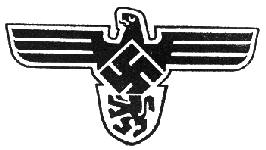Published: 21 January 2012
Last Updated: 01 June 2013

(Deutsch-Vlaemische arbeitsgemeinschaft / Vlaamsch-Duitsche arbeidsgemeenschap)
By Michael Vanhoof
The DeVlag was raised in 1935-1936 by Dr. Jef Van de Wiele, from the university of Leuven and Dr. Rolf Wilkening, from the university of Köln.
In the following years the DeVlag was occupied with cultural activities. The organisation aimed to corporate and exchange the Flemish and German students and professors between the two universities. The two groups where bind by there monthly periodical named ‘DeVlag’.
Against the will of the German members, the DeVlag cancelled all activities in 1939 due to the war threat. At the mean time the German members where secretly preparing the occupation of Belgium.
In the first year of the German occupation the DeVlag quickly re-started their cultural activities. This was possible because many German members got functions in the administration of the Militärverwaltung, due to their academic studies about Belgium before the war.
Due to the support of the VNV (Vlaamsch Nationaal Verbond), the largest nationalist movement in Flanders, in different cities new cells of the DeVlag where born, and the member strength of this new-order culture organisation increased rapidly.
In May 1941 Dr. Wilkening, in the meanwhile chef of the Kulturabeilung of the Propaganda-Abteilung Belgien, contacted the SS in Berlin. And came back with financial backup for the DeVlag. In the following months the DeVlag was re-organised into the national-socialist pattern. This lead to the appointment of SS-Obergruppenführer Gottlob Berger as Präsident der DeVlag.
In the meantime matters of dispute where raising between the DeVlag and the VNV. The DeVlag proclaimed the ideology of the SS, and wanted Flanders to be annexated by a great German Reich. While the VNV, who had found and ally in the Militärverwaltung, saw a whole other future for Flanders, as a independent state in a Germanic union.
The highpoint of these disputes where on the end of 1942, when Dr. Van de Wiele, the Landsleider der DeVlag, released his manifest, ‘Op zoek naar een Vaderland’, where he proclaimed the unconditional loyalty to the national-socialism, the Reich and the Führer. Dr. Elias, the leader of the VNV, reacted by forbidding his members to join the DeVlag.
After this decline of members, the DeVlag started to grew again, In the course of 1943 the DeVlag even grew up to 50.000 members. The arguments between the DeVlag and the VNV went on. In February 1944, there was a confrontation between Dr. Elias, Dr. Van de Wiele and the Reichsführer-SS Heinrich Himmler. Dr. Elias demanded the control over all DeVlag-activities and that the organisation turned back into a cultural organisation, but the Reichsführer-SS had only attention for Dr. Van de Wiele.
In September 1944, due to the allied advances, many members of the DeVlag fled to Germany. On the end of the year Dr. Van de Wiele finally got his annexation, however only on paper. He was appointed to Gauleiter des Reichsgaues Flandern, and became head of the Flemish people. In the prospect of the Ardennes-offensive, he organised a Landsleiding, a government in exile.
Sources used
F. Seberechts – Geschiedenis van de DeVlag, van cultuurbeweging tot politieke partij 1935-1945, 1991, Gent, Perspectief Uitgaven.
F. Seberechts – ‘Duitsch-Vlaamsche Arbeidsgemeenschap (DeVlag)’, Nieuwe Encyclopedie van de Vlaamse Beweging (NEVB), Uitgeverij Lannoo
J. Van de Wiele – Op zoek naar een Vaderland, 1942, Brussel, Uitgeverij Steenlandt.
H. Van de Vijver – ‘8 Het cultureel leven tijdens de bezetting’, België in de Tweede Wereldoorlog, Kapellen, Uitgeverij Pelckmans.


